#palaeotherium
Text
Crystal Palace Field Trip Part 3: Walking With Victorian Beasts
[Previously: the Jurassic and Cretaceous]
The final section of the Crystal Palace Dinosaur trail brings us to the Cenozoic, and a selection of ancient mammals.
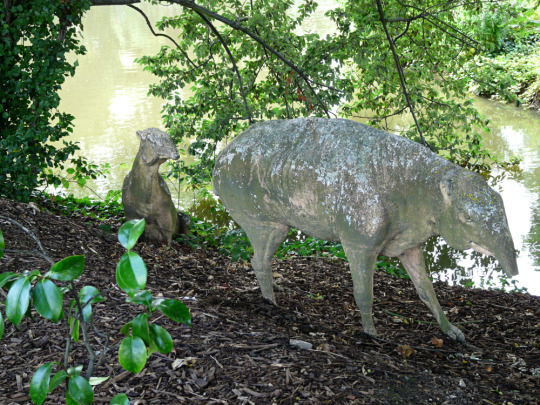
Image from 2009 by Loz Pycock (CC BY-SA 2.0)
Originally represented by three statues, there are two surviving originals of the Eocene-aged palaeotheres depicting Plagiolophus minor (the smaller sitting one) and Palaeotherium medium (the larger standing one).
The sitting palaeothere unfortunately lost its head sometime in the late 20th century, and the image above shows it with a modern fiberglass replacement. Then around 2014/2015 the new head was knocked off again, and has not yet been reattached – partly due to a recent discovery that it wasn't actually accurate to the sculpture's original design. Instead there are plans to eventually restore it with a much more faithful head.
These early odd-toed ungulates were already known from near-complete skeletons in the 1850s, and are depicted here as tapir-like animals with short trunks based on the scientific opinion of the time. We now think their heads would have looked more horse-like, without trunks, but otherwise they're not too far off modern reconstructions.
There was also something exciting nearby:

The recently-recreated Palaeotherium magnum!
This sculpture went missing sometime after the 1950s, and its existence was almost completely forgotten until archive images of it were discovered a few years ago. Funds were raised to create a replica as accurate to the original as possible, and in summer 2023 (just a month before the date of my visit) this larger palaeothere species finally rejoined its companions in the park.
Compared to the other palaeotheres this one is weird, though. Much chonkier, wrinkly, and with big eyes and an almost cartoonish tubular trunk. It seems to have taken a lot of anatomical inspiration from animals like rhinos and elephants, since in the mid-1800s odd-toed ungulates were grouped together with "pachyderms".
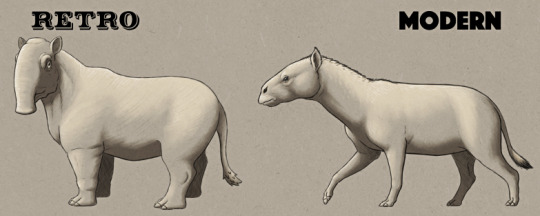
———
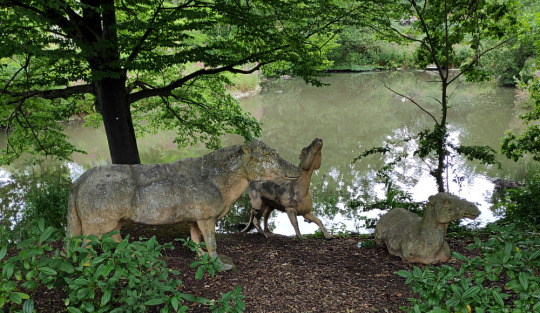
Next is Anoplotherium, an Eocene even-toed ungulate distantly related to modern camels.
(Apparently the sculpture closest to the water is a replica of a now-lost original, recreated from photo references in the same manner as the new Palaeotherium magnum. I can't find a definite reference for when this one was done, though – I'd guess probably during the last round of major renovations in the early 2000s, at the same time as the now-destroyed Jurassic pterosaur replicas?)
Anoplotherium commune is a rather obscure species today, but it was one of the first early Cenozoic fossil mammals to be recognized by science in the early 1800s. Depicted here as small camel-like animals, the three statues are positioned near the water's edge to reflect the Victorian idea that they were semi-aquatic based on their muscular tails.
Today we instead think these animals were fully terrestrial, using their tails to balance themselves while rearing up to reach higher vegetation. Their heads would also have looked a bit less camel-like, but otherwise the Crystal Palace trio are still really good representations.
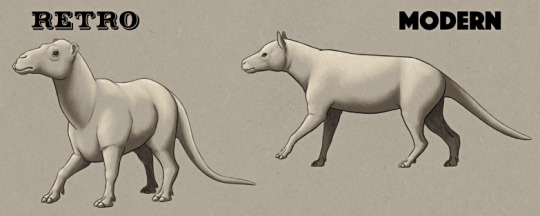
———

Next is a sculpture that's very easy to miss in the current overgrown state.
Who's that peeking over the bushes?
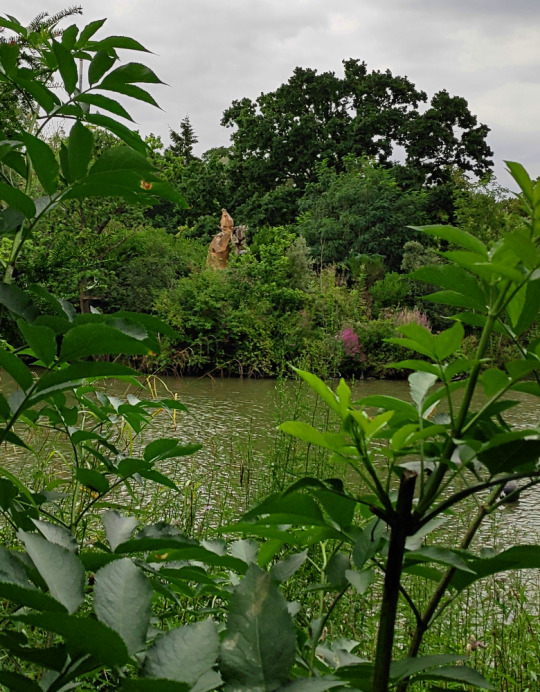
Going all the way around to the far side of the lake reveals a distant glimpse of the Pliocene-to-Holocene giant ground sloth Megatherium.
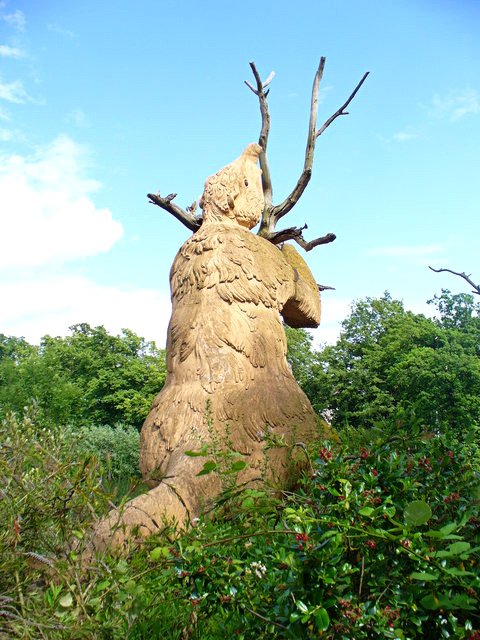
A better view of the Megatherium | "Tree Hugger" by Colin Smith (CC BY-SA 2.0)
Fossils of Megatherium americanum had been known since the late 1700s, but the 1854 Crystal Palace statue was still one of the first life reconstructions of this animal. Its anatomy is actually very close to our modern understanding, depicted with correctly inward-turned feet and sitting upright to feed on a tree with its tail acting as a "tripod".
However, we now know it didn't have a trunk-like nose, but instead probably had prehensile lips more like those of a modern black rhino.
Something weird also appears to have happened to the Crystal Palace Megatherium's hands. Early illustrations of the sculpture all consistently show it with the typical long claws of a sloth, but today it's missing its right hand and its left has only a strangely stumpy paw – suggesting that at some point in the intervening 170 years there was an unrecorded crude repair.
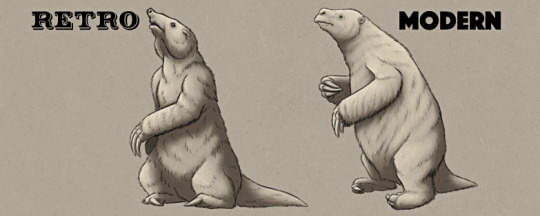
———
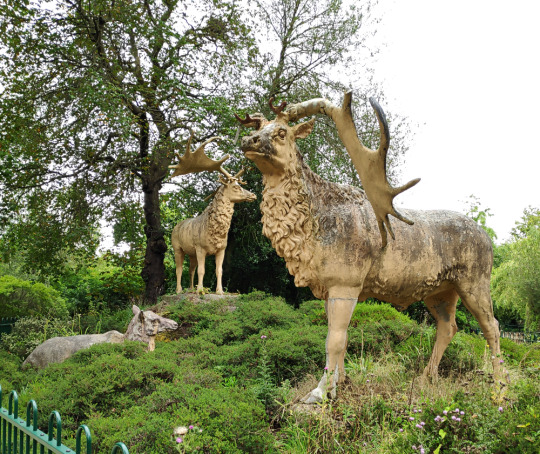
And finally we end the trail with three Megaloceros, the Pleistocene-to-Holocene "Irish Elk" that's actually neither exclusively Irish nor an elk.
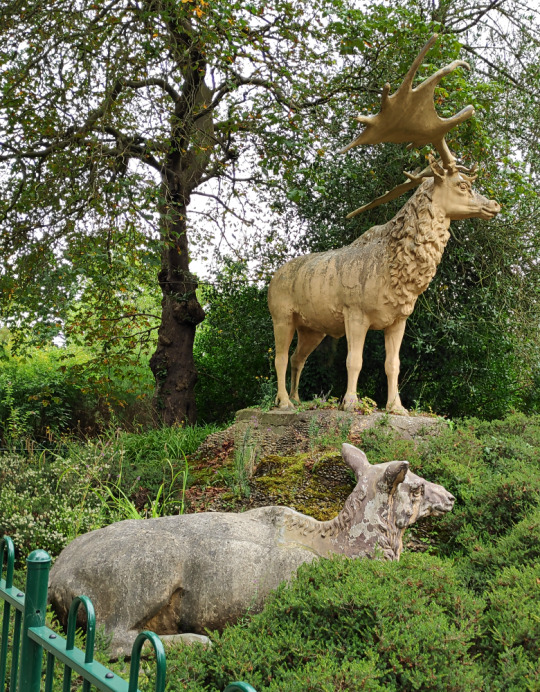
A closer look at the second stag and the doe.
There was originally a fourth giant deer sculpture in this herd, a second resting doe, but it was destroyed sometime during the mid-20th century. The stags also initially had real fossil antlers attached to their heads, but these were removed and replaced with less accurate versions at some point by the mid-20th century.
One of the stags' antlers suffered some damage in 2020, ending up drooping, and since then one antler has either fallen off or been removed.
In the 1850s Megaloceros giganteus was thought to be closely related to deer in the genus Cervus, and so the Crystal Palace reconstructions seem to be based on modern wapiti – specifically in their winter coats, fitting for ice age animals – since both the stags and the doe sport distinctive thick neck manes.
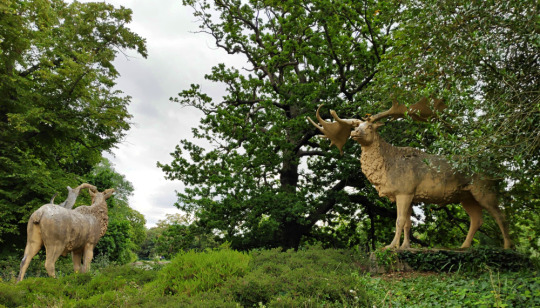
The stags from the other side.
We now know Megaloceros was actually much more closely related to modern fallow deer, and so probably resembled them more than wapiti. Cave art also shows that it had a hump on its shoulders, and even gives us an idea of what its coloration was.
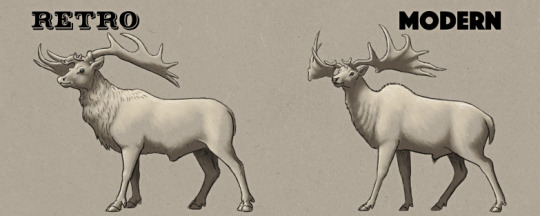
———
…But wait!
There's actually one more thing.
A small statue sitting on the far side of the deer herd, missing its ears, and seemingly representing a Megaloceros fawn.
Except it's actually something very different and very special.
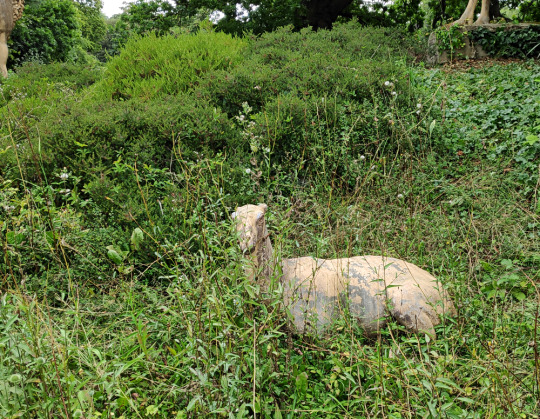
Ceci n'est pas un cerf.
Some recent investigation work revealed some surprising information about the Crystal Palace mammal statues – much like the nearly-forgotten large Palaeotherium, there was originally an entire group of four small Eocene-aged llama-like Xiphodon gracilis that had disappeared from living memory.
There was also no historic record of a fawn with the giant deer, but instead a suspiciously similar-looking sitting sculpture is illustrated among what we now known are the four missing Xiphodon in early records.
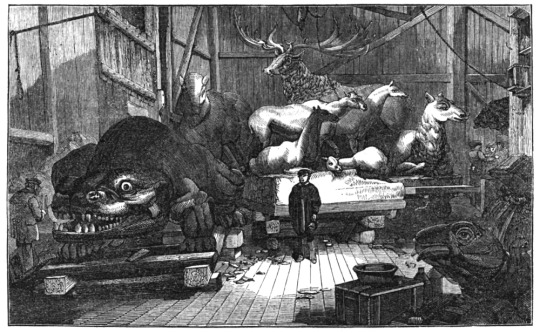
An 1853 illustration of the sculpture workshop. The four Xiphodon are shown in the center, directly in front of a Megaloceros stag and doe. (public domain)
Somewhere in the late 19th or early 20th century three of the Xiphodon must have been completely lost, and the remaining individual was misidentified as a fawn and placed with the giant deer herd.
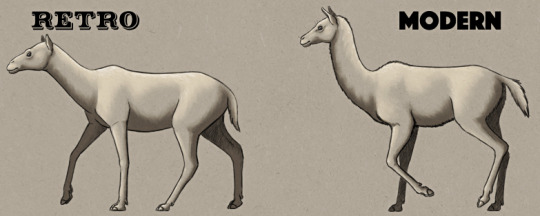
———
Rediscovering a whole extra species among the Crystal Palace statues is exciting, but it also demonstrates just how much of these sculptures' history has gone completely undocumented.
The mammal statues especially seem to have suffered the most out of the "Dinosaur Court", being often overlooked, neglected, disrespected (at one point the Megatherium was inside a goat pen in a petting zoo!), and subjected to cruder repairs. A total of five original statues are now known to be missing from this Cenozoic section – the original large Palaeotherium, the three other Xiphodon, and the second Megaloceros doe – compared to the two pterosaurs lost from the Mesozoic island.
Hopefully the excellent recreation of the lost Palaeotherium magnum is the start of a long overdue new lease of life and conservation attention for all of the Crystal Palace sculptures. It was disappointing seeing them all in such an overgrown state, and with signs of ongoing disrepair in places such as the plant growing out of the big ichthyosaur's back.
But there has been some resurgence of interest and public attention in the Crystal Palace sculptures over the last few years, so with any luck these historic pieces of early paleoart will survive on to their 200th anniversary and beyond, to keep on reminding us of where things began and how far our understanding of prehistoric life has since come.
#field trip!#crystal palace dinosaurs#retrosaurs#i love them your honor#crystal palace park#crystal palace#palaeotherium#anoplotherium#xiphodon#ceci n'est pas un cerf#megaloceros#ungulate#megatherium#ground sloth#mammal#paleontology#vintage paleoart#art#proper art post tomorrow#this took longer than expected#also apologies for my potato-quality camera#i'm an illustrator not a photographer
321 notes
·
View notes
Text

Anoplotherium, Palaeotherium?, Deinotherium, Mylodon & Megatherium illustration published in German magazine Die Gartenlaube (1854), p. 151
https://books.google.co.uk/books?id=DaVLAAAAcAAJ
35 notes
·
View notes
Text

Palaeotherium, yet another perissodactyl.
4 notes
·
View notes
Text
Little teen beauty fuck hard
Me la chupa con antifaz de gatita
Chica japonesa mamando pene en Tokyo
Model boys cock gay sex After school snack
Calentando su conchita estrecha
Fucking Young Teen at the peach get caught
Hermosa pendeja hace un pete en el auto
Grace pee masturbation magic wand fingers penetration orgasm famegirls
Bailecito casero
sapna getting undressed on bed
#spur-galled#ill-mannerly#Hylidae#Taurini#burroweed#naley#gargalize#proterandric#furbelow#TCM#Leninism#Palaeotherium#octal#helmet#dishclout#czaristic#HEHO#vineries#pipetting#factories
0 notes
Text
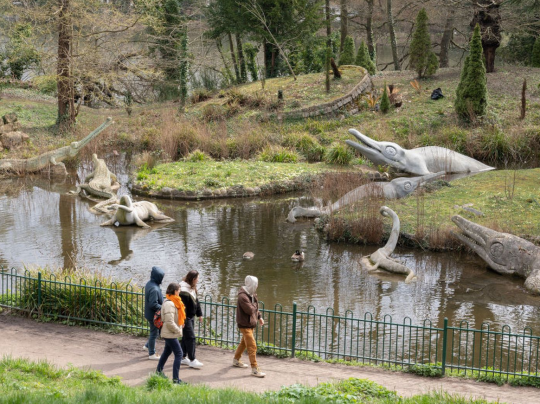
[ Visitors pass by some of the iconic sculptures of prehistoric life within Crystal Palace Park. Photo by Richard Baker. ]
"When the Crystal Palace and Park opened in south London in 1854, it was an instant sensation. Visitors came from far and wide to see the giant glass structure that had been rebuilt there, bigger and better, after the Great Exhibition of 1851 in Hyde Park. Wide-eyed spectators wandered freely through Egyptian and Medieval Courts, delighted in high-wire circus acts, and were transported by a 4,000-piece orchestra.
Tucked away in a corner of the vast gardens that fanned out from the palace, past sweeping terraces and more fountains than even at Versailles, was a smaller but no less ambitious attraction. Scattered across several islands in the middle of a lake stood three dozen life-size sculptures of prehistoric animals, including several dinosaurs up to 30 feet long—the world’s first attempt to model them at full scale.
The Crystal Palace Dinosaurs were the work of Benjamin Waterhouse Hawkins, a natural history artist who, aided by some of the leading scientists of the day, had dreamt up a grand experiment in visual education, bringing to life the “dry bones or oddly shaped stones” found in the British Museum and introducing the masses to the burgeoning science of paleontology. By reconstructing Britain’s long-extinct animals, he hoped to “render the appearance and names of the ancient inhabitants of our globe as familiar as household words.”
The palace burned down in the 1930s, but, almost 170 years after they were crafted, most of Hawkins’ original sculptures still stand sentry in the park. Today, they’re mostly famous for being wildly inaccurate. With few complete fossils to work off, Hawkins had to use his imagination and the advice of comparative anatomists to breathe life into his models, which, in addition to four true dinosaurs, also depict prehistoric mammals, reptiles and amphibians. As a result, the sculptures look suspiciously like many modern-day creatures.
“People kind of scoff and giggle, because they look so wrong today, but at the time they were really cutting-edge,” says Bob Nicholls, a paleoartist who, through careful study of archival images, recently reconstructed a lost sculpture that had disappeared from the park sometime in the 1960s. His tapir-like model of Palaeotherium magnum, an animal we now know looked a lot more like a horse, was unveiled in July and now stands among Hawkins’ own surviving creations."
Read more: "How a Victorian Dinosaur Park Became a Time Capsule of Early Paleontology" by Yannic Rack.
#palaeoblr#Crystal Palace#Crystal Palace Dinosaurs#Dinosaurs#Article#Information#London#England#Photo#Sculptures
261 notes
·
View notes
Text

IT'S COMING HOME!
I have painstakingly reconstructed Benjamin Waterhouse Hawkins' Palaeotherium magnum sculpture. Lost decades ago, join us (Ellinor Michel, Mark Witton, Friends of Crystal Palace Dinosaurs) this Sunday to see its return.
More here: https://www.londonfestivalofarchitecture.org/event/beyond-the-dinosaurs-a-series-of-tours/
#Art#Painting#PaleoArt#PalaeoArt#SciArt#SciCom#DigitalArt#Illustration#Dinosaurs#Birds#Reptiles#Palaeontology#Paleontology#paleo#clay sculpting
286 notes
·
View notes
Text
"As Cuvier could correctly describe a whole animal by the contemplation of a single bone"
Meet Baron Georges Cuvier. Father of Modern Paleontology. Student of Scientific Racism. Anti-evolutionist. Proponent of theories of extinction.
In this context, Holmes is probably talking about his paleontological studies. Cuvier had come across a single tooth from a limestone quarry at Montmarte, which he studied to claim that it belonged to an animal part horse and part tapir. He was proved right when the near complete remains of such an animal surfaced, again at Montmarte. It was what we today call Palaeotherium sp. Even today, teeth and jawbones are invaluable finds.
A nice reference to some pioneering paleontology, coming from a very controversial figure of science.
20 notes
·
View notes
Text

Odd-toed ungulate (Palaeotherium) illustrated by Charles Dessalines D' Orbigny
0 notes
Text
A Victorian Dinosaur Park Finds Its Way in the 21st Century

Imagine: It’s 1854. The concept of evolution won’t be introduced for another five years or so. The word dinosaur is only about a decade old. There are no David Attenborough documentaries teaching you about extinct animals.Now imagine yourself as a resident of Victorian London, walking into Crystal Palace Park in the southeastern part of the city. There you encounter dozens of three-dimensional dinosaurs and ancient mammals you could have never imagined, made of clay, brick and other available building materials. They are arranged in small groups, poking out from behind trees and bushes, some of them towering over their human visitors out for an afternoon stroll.Except you don’t have to imagine too hard, because those statues are still there, some 170 years later. They’re a little worse for wear and are no longer considered scientifically accurate. But they delight visitors all the same. And this month, thanks to conservators, scientists and a group called the Friends of Crystal Palace Dinosaurs, their Paleolithic picnic party grew a little, with the addition of a new statue — well, a recreation of an old statue — to replace one that disappeared in the 1960s.
A ‘revolutionary’ walk through time, for its time
The statues, built by the 19th century artist Benjamin Waterhouse Hawkins, are part of a reconstructed geological walk through time, starting 260 million years ago. They were the first of their kind, much to the admiration of the public at the time.“It was educational for the Victorians,” said Adrian Lister, a paleobiologist at the Natural History Museum in London. “It was revolutionary.”The sculptures by Mr. Hawkins, who was one of the best-known natural history sculptors at the time, were supposed to educate and entertain visitors near the Crystal Palace, an exhibition space that had been built for London’s Great Exhibition of 1851. After the exhibition, that palace moved to the area to which it gives its name today. (The statues have outlived the actual palace, which burned down in 1936.)The statues popularized science, bringing the idea of extinction and changing environments to regular people, not just the upper classes, said Ellinor Michel, an evolutionary biologist and the chair of Friends of Crystal Palace Dinosaurs. “This was the birthplace of large-scale ‘edu-tainment,’” said Ms. Michel, who also lives nearby.The statues do not reflect the extinct animals based on what we know today. Within decades of their construction they were out of date, Ms. Michel said, because of new scientific discoveries.But accuracy isn’t the point, Ms. Michel said. “Science moves and science self improves,” she said.
‘They weren’t built to last that long.’
Of the 38 original statues, 30 remain, and they show every bit of their almost 170 years.The statues are made from whatever materials were available at the time, and as a result, are plagued by issues like rusting iron. While they’ve been maintained over the years, some look weathered, and at least one of them is missing a head.“They weren’t built to last that long,” said Simon Buteux of Historic England, an organization that advises the government on England’s heritage. “We’ve got a huge problem of conserving them.”What’s important to maintain, Mr. Buteux said, is the original feeling of how revolutionary these statues were in the 19th century.“It was fresh, it was new, it was cutting edge,” he added. “That’s what we want to capture.”
‘It’s got a silly face.’
No one knows quite what happened to the original Palaeotherium magnum, which disappeared from the park in the 1960s. An herbivore that was loosely related to horses, the statue looked something like a horse with stumpy snout.Seven other statues are also missing. The circumstances surrounding most of the disappearances are “giant mysteries,” Ms. Michel said.Bob Nicholls, an artist who focuses on prehistoric animals, proposed bringing back the Palaeotherium magnum to the park. The Friends of Crystal Palace Park Dinosaurs then secured funding that helped make his recreated Palaeotherium magnum a reality. The new statue was installed in the park in early July.To recreate what Mr. Hawkins imagined the herbivore might have looked like, Mr. Nicholls turned to the few available photographs of it from the 1950s and ’60s.It took him about six weeks to build the new statue, which is hollow inside and made of fiberglass, a durable material. He’s happy with how it turned out, he said: “It’s got a silly face.”“The new sculpture draws attention to the importance of the site in the history of science,” Mr. Lister, the paleobiologist, said.About half a million people visit the statues annually, according to the Friends of Crystal Palace Dinosaurs. And they continue to inspire awe, with parents taking pictures of their children in front of them and lingering by the large statues.On a recent sunny afternoon, Jenny Steel, a local resident who walks through the park multiple times a week, was on her way to admire the newest addition. “They are quite larger than life,” she said.Just a bit further along the walk, Ian Baxter, who has lived in the area for 50 years, was sitting on a rock near the statues with his poodle, Rory. Back when he was a teenager, he said, he used to climb into the hollow structures. Today, he looks at them from the other side. “I like the dinosaurs,” he said. “Of course I do.”Another local resident, Gabriel Birch, said he visits the park at least once a month.“We come here for the dinosaurs,” he said. “My three-year-old thinks they’re real.”
Source link
Read the full article
0 notes
Text
Beware! New monster on the loose in Crystal Palace Park
If you are very careful, go gently and quietly so as not to scare it, you have a chance of spotting in the middle of a south London park a prehistoric creature that has not been seen for millions of years.
Startled: the original palaeotherium magnum sculpture went missing 60 years ago
Tucked away amid the undergrowth, on an island in the lake of Crystal Palace Park, is where you will find it… a…

View On WordPress
0 notes
Photo
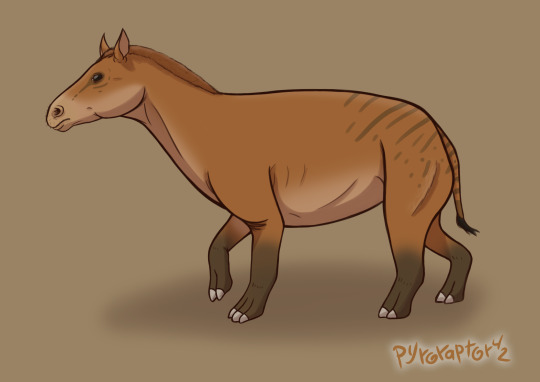


Palaeotherium (old beast) was a weird creature with the face of a horse and the body of a tapir, which makes sense since it was related to them. It lived in the Eocene epoch of Europe along smaller more horse-related creatures like Hyracotherium.
🐎
While most other mammals from its time were small, Palaeotherium was about 1.50 m high. Here we see it compared to a cartoon british woman that is 1.65 meters high.
15 notes
·
View notes
Photo
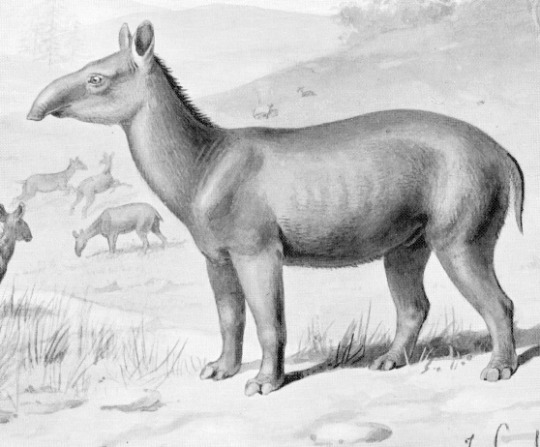
Palaeotherium, 1905, by Joseph Smit
52 notes
·
View notes
Text

"Le grand Palaeotherium" from La terre avant le déluge [The world before the deluge] by Louis Figuier, 1863
25 notes
·
View notes
Photo

Palaeotherium magnum by RomanYevseyev
0 notes
Text
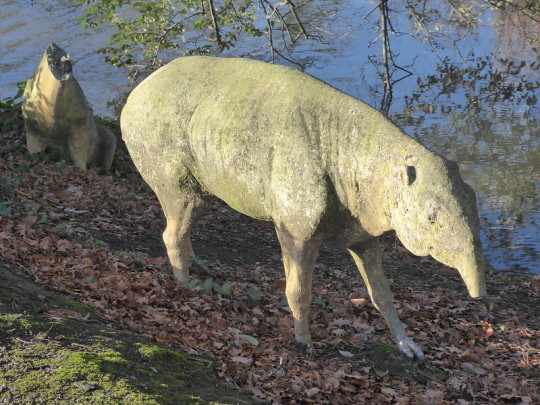
crystal palace palaeotherium GO
https://www.flickr.com/photos/nigel_turner/49224347083/in/pool-crystalpalace/
9 notes
·
View notes
Photo

Palaeotherium. Das weltall. 1859.
78 notes
·
View notes